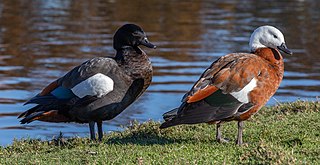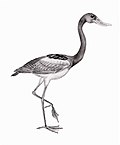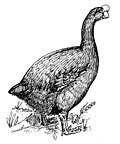
The Anatidae are the biological family of water birds that includes ducks, geese, and swans. The family has a cosmopolitan distribution, occurring on all the world's continents except Antarctica. These birds are adapted for swimming, floating on the water surface, and, in some cases, diving in at least shallow water. The family contains around 174 species in 43 genera.

Anseriformes is an order of birds also known as waterfowl that comprises about 180 living species of birds in three families: Anhimidae, Anseranatidae, and Anatidae, the largest family, which includes over 170 species of waterfowl, among them the ducks, geese, and swans. Most modern species in the order are highly adapted for an aquatic existence at the water surface. With the exception of screamers, males have penises, a trait that has been lost in the Neoaves, the clade consisting of all other modern birds except the galliformes and paleognaths. Due to their aquatic nature, most species are web-footed.

The Tadorninae is the shelduck-sheldgoose subfamily of the Anatidae, the biological family that includes the ducks and most duck-like waterfowl such as the geese and swans.

The shelducks, most species of which are found in the genus Tadorna, are a group of large birds in the Tadorninae subfamily of the Anatidae, the biological family that includes the ducks and most duck-like waterfowl such as the geese and swans.

The common shelduck is a waterfowl species of the shelduck genus, Tadorna. It is widespread and common in the Euro-Siberian region of the Palearctic, mainly breeding in temperate and wintering in subtropical regions; in winter, it can also be found in the Maghreb.

The Australian shelduck, also known as the chestnut-breasted shelduck or mountain duck, is a shelduck, a group of large goose-like ducks part of the bird family Anatidae. The genus name Tadorna comes from Celtic roots and means "pied waterfowl". They have a striking chestnut-coloured breast and black body. They are protected under the National Parks and Wildlife Act 1974.

The ruddy shelduck, known in India as the Brahminy duck, is a member of the family Anatidae. It is a distinctive waterfowl, 58 to 70 cm in length with a wingspan of 110 to 135 cm. It has orange-brown body plumage with a paler head, while the tail and the flight feathers in the wings are black, contrasting with the white wing-coverts. It is a migratory bird, wintering in the Indian subcontinent and breeding in southeastern Europe and central Asia, though there are small resident populations in North Africa. It has a loud honking call.

The knob-billed duck or African comb duck is a type of duck found along the tropical/sub-tropical wetlands and waterways of Sub-Saharan Africa and the island of Madagascar, as well as most of South Asia and mainland Indochina.

The black geese of the genus Branta are waterfowl belonging to the true geese and swans subfamily Anserinae. They occur in the northern coastal regions of the Palearctic and all over North America, migrating to more southerly coasts in winter, and as resident birds in the Hawaiian Islands. Alone in the Southern Hemisphere, a self-sustaining feral population derived from introduced Canada geese is also found in New Zealand.

Alopochen is a genus of the bird family Anatidae, part of the subfamily Tadorninae along with the shelducks. It contains one extant species, the Egyptian goose, and three or four species which became extinct in the last 1,000 years or so. The Egyptian goose is native to mainland Africa, and the extinct species are from Madagascar and the Mascarene Islands.

The crested shelduck, or Korean crested shelduck, is a species of bird in the family Anatidae. It is critically endangered. The male crested shelduck has a greenish-black crown, breast, primaries, and tail, while the rest of its face, chin, and throat are brownish black. The male's belly, undertail coverts, and flanks are a dark grey with black striations. The upper wing coverts are white, while its speculum is an iridescent green. The female has a white eye ring, black crest, white face, chin, throat, neck, and uppers wing coverts and a dark brown body with white striations. Additionally, both sexes have a distinctive green tuft of feathers protruding from the head.

The blue-winged goose is a waterfowl species which is endemic to Ethiopia. It is the only member of the genus Cyanochen.

The South African shelduck or Cape shelduck is a species of shelduck, a group of large goose-like birds which are part of the bird family Anatidae, which also includes the swans, geese and ducks. This is a common species native to southern Africa.

The paradise shelduck, also known as the paradise duck, or pūtangitangi in Māori, is a species of shelduck, a group of goose-like ducks, which is endemic to New Zealand. Johann Friedrich Gmelin placed it in the genus Anas with the ducks, geese, and swans. Both the male and female have striking plumages: the male has a black head and barred black body and the female has a white head with a chestnut body. They weigh between 1.09 and 2 kg and are between 63 and 71 cm in length.

The radjah shelduck, is a species of shelduck found mostly in New Guinea and Australia, and also on some of the Moluccas. It is known alternatively as the raja shelduck, black-backed shelduck, or in Australia as the Burdekin duck.
Ngapakaldia is an extinct genus of diprotodontid marsupials, related to the modern koala and wombat. Around the size of a sheep, it was a ground-dwelling herbivore that lived around the vegetated shores of lakes in Central Australia during the Late Oligocene.
Pinpanetta is an extinct genus of birds, in the duck family, from the Late Oligocene of central Australia. The genus name comes from Lake Pinpa, in the Lake Eyre Basin of north-eastern South Australia, with reference to the Pinpa Local Fauna from which much of the descriptive fossil material derives, and from the Greek netta (“duck”). It comprises three species:
Miotadorna is a genus of extinct tadornine ducks from the Miocene of New Zealand. It contains two species, M. sanctibathansi, and M. catrionae.
Bucks Lake Game Reserve, formerly the Bucks Lake National Park, is a protected area located in the Limestone Coast of South Australia about 40 kilometres south-west of Mount Gambier and immediately east of the township of Carpenter Rocks. The game reserve was originally created as the Bucks Lake National Park in 1968 under the National Parks Act 1966 and was re-proclaimed as a game reserve under the National Parks and Wildlife Act 1972 for the purpose of the conservation of wildlife and management of game. The game reserve is used for duck hunting with species being harvested including grey teal, chestnut teal, Pacific black duck, pink-eared duck and Australian shelduck. Hunting is conducted during a proclaimed open season with hunters requiring to have an ‘endorsed hunting permit’ and only to harvest maximum numbers of specific species.
Anabernicula is an extinct genus of waterfowl related to shelducks that existed from the Pliocene to the Pleistocene. Four species have been described: A. minuscula, A. gracilenta, A. oregonensis, and A. robusta.
















